Here's some bad news: friction can kill your mobile app.
And that's not all. No matter how many hours you pour into development, planning, and promotion, you can't avoid all bugs and UX mistakes. Especially in the early days, updates and fixes are all developers' bread and butter.
But the users expect a seamless app experience. And if you don't react early enough, customer satisfaction will drop—and so will app store ratings and retention rate.
So, is there anything you can do?
Sure, there is: set up mobile app surveys to capture valuable user feedback.
With the right mobile survey questions popping up at the right moment in your app, you will catch your users when they're most engaged. And if you play your cards right—you will get more 5-star reviews and avoid negative ones.
In this article, you'll find:
- A comprehensive list of benefits of mobile app survey and best practices;
- The most relevant mobile app survey questions;
- Ready-to-go in-app survey templates to implement in your mobile app in minutes.
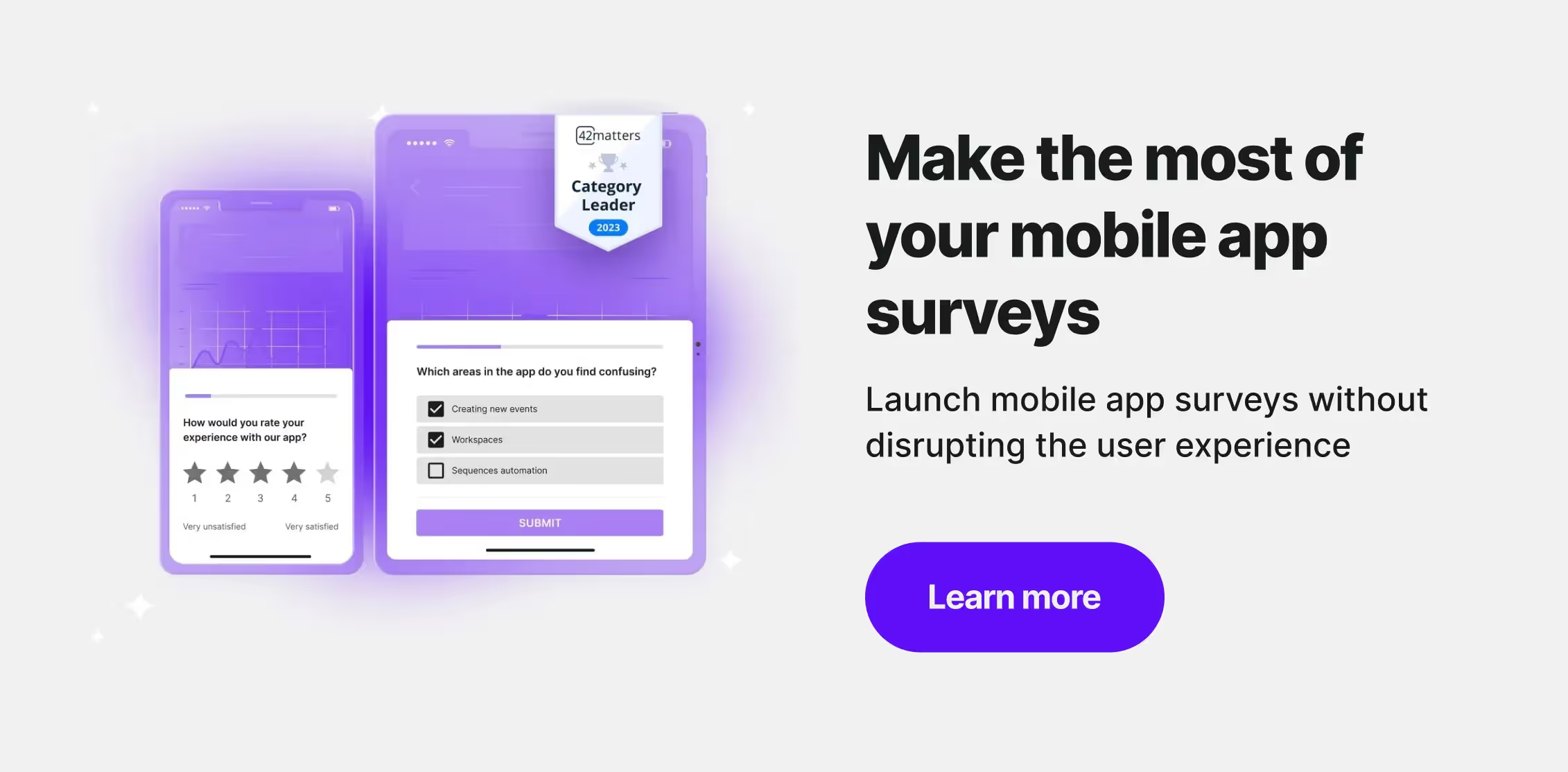
What are mobile app surveys?
Mobile app surveys are a tool for gathering feedback from your app users directly within the app. These surveys let you understand how people interact with your app, what needs improvement, and what keeps them coming back. By collecting user feedback, you can improve the app experience, leading to better user retention and higher engagement.
You can integrate surveys into both Android and iOS apps and customize them to focus on specific areas like app performance or design. Since you're engaging users while they’re active in the app, you'll see higher response rates than traditional methods.
Adding mobile app surveys to your strategy is a smart way to boost customer satisfaction and drive growth.
Benefits of mobile app surveys
Mobile app surveys are a must if you want to keep up with your users and competition. Here are a few benefits of a well-designed mobile survey.
1. Improve and speed up mobile app development
An in-app survey will help you spot bugs and UX (user experience) shortcomings in the early development stage.
Ask your app users if they've encountered any issues. You can request general in-app feedback or inquire about specific features.
The best survey tools, such as Survicate, will let you run targeted surveys. They can appear in particular parts of the app or only to a specific group of users. This way, you'll quickly discover which parts of your apps need fixing. The survey template below allows you to gauge your users' impressions of your app:
2. Design your product roadmap based on your users' needs
User input will let you create a product roadmap and prioritize tasks based on data, not guesswork.
Don't be afraid to ask your mobile app users what feature they'd like to see. You can do that by adding open-ended questions to your surveys to collect qualitative feedback.
Add the most frequently repeating app features to your roadmap. If you receive a lot of customer feedback, you can run an additional in-app survey asking your users to choose from the most popular options.
This product feature prioritization survey will help you discover the why behind your users' needs:
3. Keep your mobile app bug-free
No matter how many scenarios you run, you can't predict every possible friction in user and customer experience. This is why you should use surveys even in stable apps. Give your users a possibility to voice their negative feedback—and act on it. You'll spot emerging issues early and keep your customers satisfied.
For even deeper customer journey insights, combine qualitative feedback from your mobile app surveys with quantitative data from your product analytics tools.
For example, if you notice your users often abandon your app after using a specific feature, trigger a survey at that touchpoint and ask your customers what exactly made them leave and how you could improve for them.

Many survey tools, Survicate included, offer native integrations that let you streamline feedback directly to your analytics software, like Mixpanel, Amplitude, Segment, Productboard, or UXCam.
.avif)
The product satisfaction survey template below is a great example of how to make sure your product caters to your users' needs.
4. Catch negative feedback before it turns into bad reviews
If you have a lot of negative survey responses, your app store rating will reflect that. Don't blindly ask every user to leave you an online review. Instead, use skip logic—create different paths for the respondents depending on their previous answers.
Ask unsatisfied users what they dislike about your app, and try to fix the shortcomings. With survey apps such as Survicate, you will receive notifications of every response, so you'll have a chance to react in real time. If your users notice you care, you might avoid a few bad reviews or even turn a hater into a fan.
5. Reap the benefits of good word of mouth
Do you get a lot of positive survey responses? Why not ask your loyal users to rate you in an app store, recommend you to their friends, or become beta testers?
Add a call to action to your in-app survey to redirect your users wherever you want. You can also use an incentive to motivate them.
Use this quick in-app NPS survey that redirects happy customers to G2 reviews:
6. Understand how your users feel about your brand
If the mobile app is your flagship product, it's a good place for a general customer experience survey.
Catch your customers in their preferred channel when they're the most engaged—and gauge their satisfaction and loyalty with an NPS (Net Promoter Score) or CSAT (Customer Satisfaction Score) survey such as the one below:
7. Use surveys as an extra communication channel
Mobile app surveys are an excellent point of contact with your customers. Don't shy away from open-ended survey questions, as long as they're well-designed—they'll let you hear your customers' voices.
To ease the pain of going through tons of qualitative feedback, use Insights Hub. It is a feature that automatically categorizes all your open-text user feedback, not only the one coming from surveys, but also online reviews, interviews, customer service interactions, and more. And if you have more questions, ask Research Assistant, an AI chat built into Survicate that will answer any question based on your feedback collection.
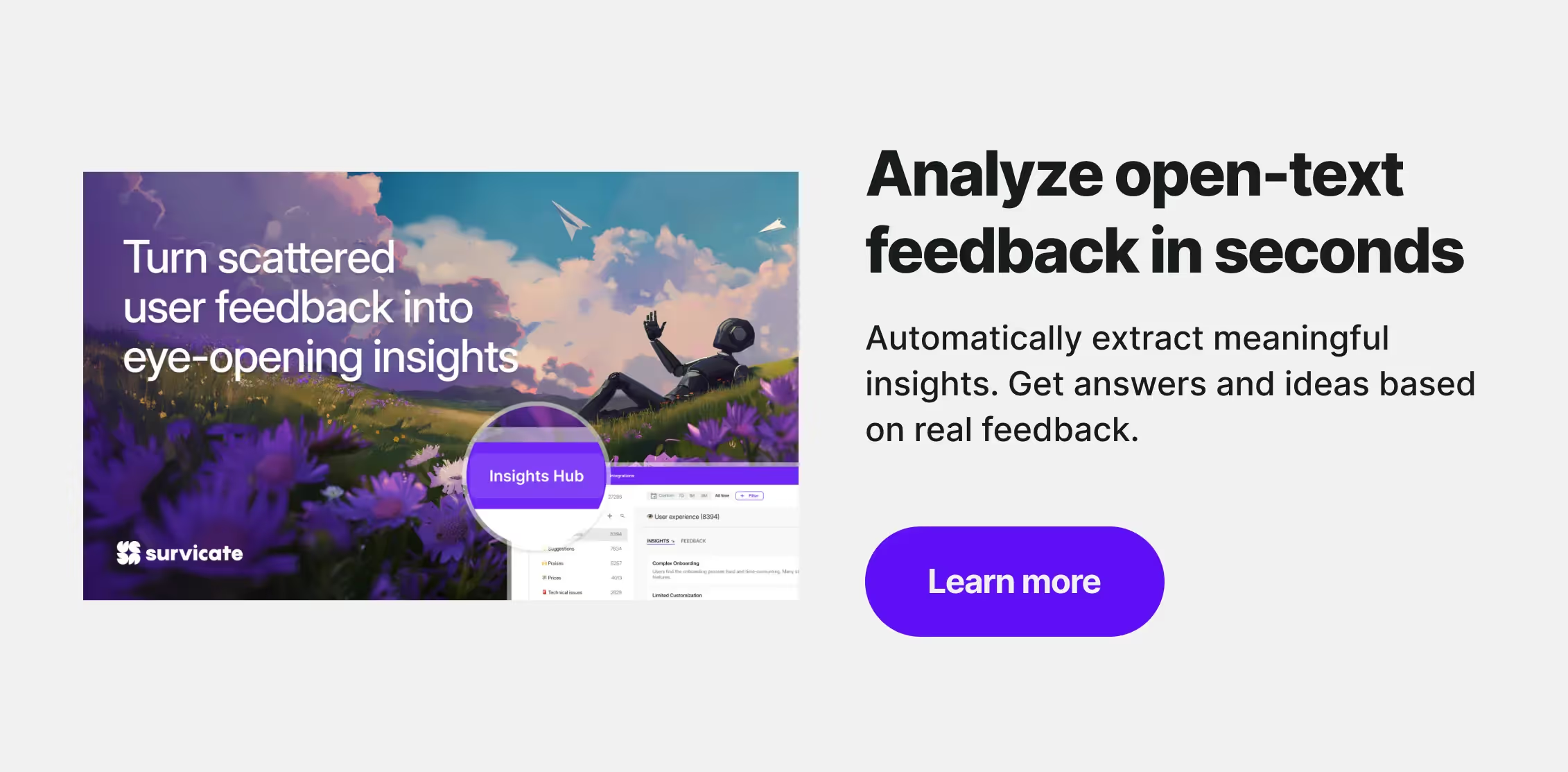
You can also turn your surveys into mini contact forms. For example, when you run a new customer survey, ask if they'd like to be contacted by customer support at the end.
Give your customers all the attention they need to prevent churn with the new customer survey:
13 best mobile app survey questions
Keeping your app user-friendly will ensure all the time and resources poured into app development won't go to waste. To achieve this, you should run mobile app surveys at every stage of your app development.
But to really make your surveys count, you have to ask the right questions.
There are two main question types you can choose from:
- Closed-ended questions, where the user has to select an answer from a limited list.
- Open-ended questions, to which the user responds using their own words.
Combining the two types will get you qualitative results (that you can benchmark and turn into KPIs) and actionable feedback.
Here's a list of 13 questions that will help you design your perfect survey, divided into four categories that reflect your mobile app's development stage:
- early development technical questions
- early development features scouting
- product roadmap survey questions
- general customer experience questions
And if you don't feel like designing the survey yourself and want something tried and tested, why not use our AI-powered Survey Library, which is full of ready-to-go survey templates? Or, you can create one with AI by simply describing what you need.
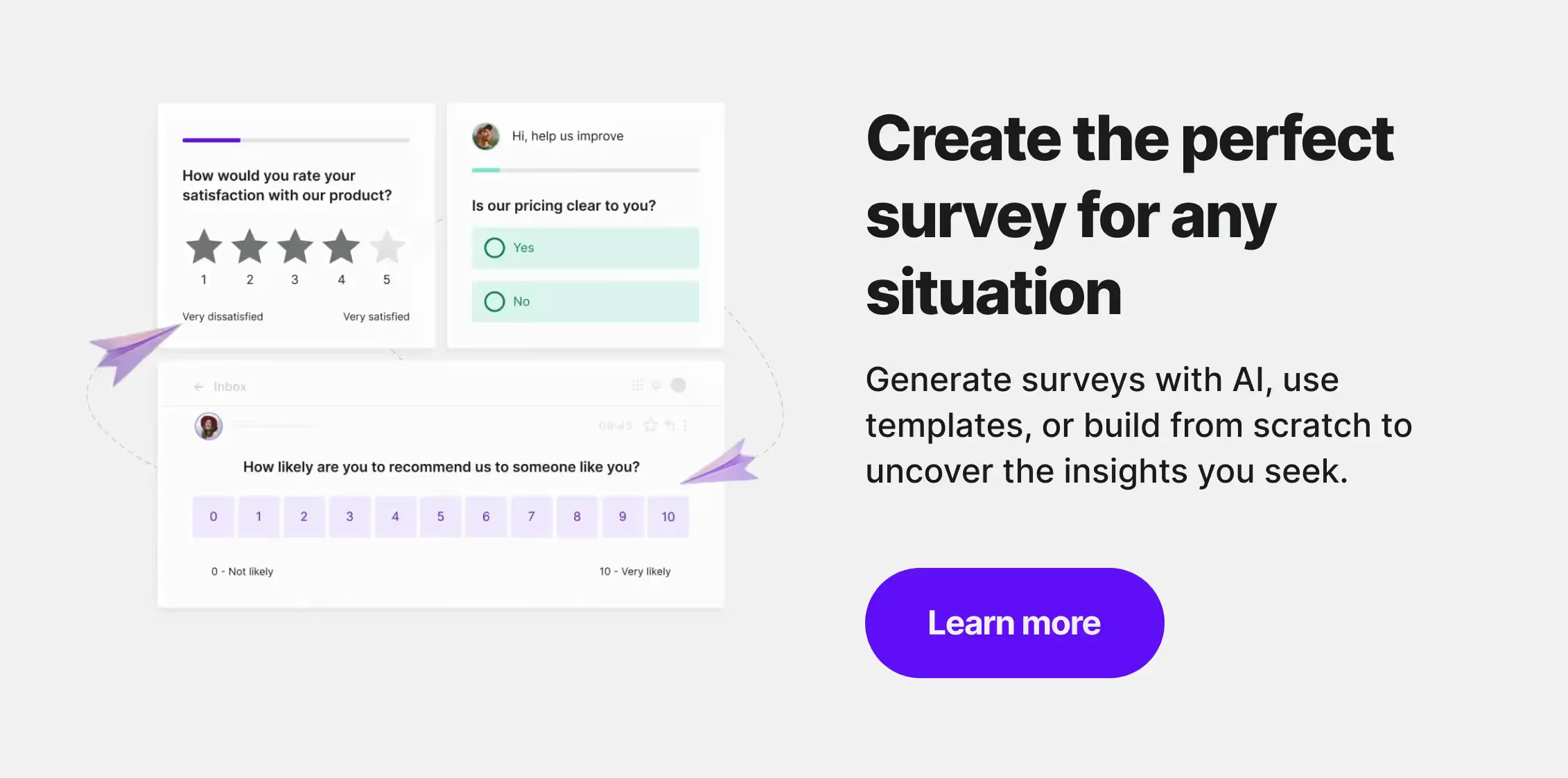
Questions for an early development technical survey
#1. The app made it easy for me to [perform an action]
With this straightforward statement, you will measure if your mobile app's features are easy to use.
This question is a part of the Customer Effort Score (CES) survey. You can pair it up with an additional open-ended question (such as “What would you change about this feature?”) to discover your users' frustrations and any in-app friction points.
The action in this question might be about any new feature you've just rolled out—the payment process, the search function, the tag system, you name it.
Here's the complete Customer Effort Score survey template:
#2. How does the app run after the update?
No amount of testing will let you predict all potential UX issues. Ask your users if they've encountered any challenges—especially if your mobile app is brand new or you've just developed a new feature.
This question works best as a two-part survey. Always ask the users who aren't completely satisfied to describe the issues in detail.
💡 One more tip: filter responses based on the user's device. This will help you identify the source of the problem. You can do that by integrating your survey tool with your CRM to get more data points—or simply by adding a question about the respondent's device and operating system.
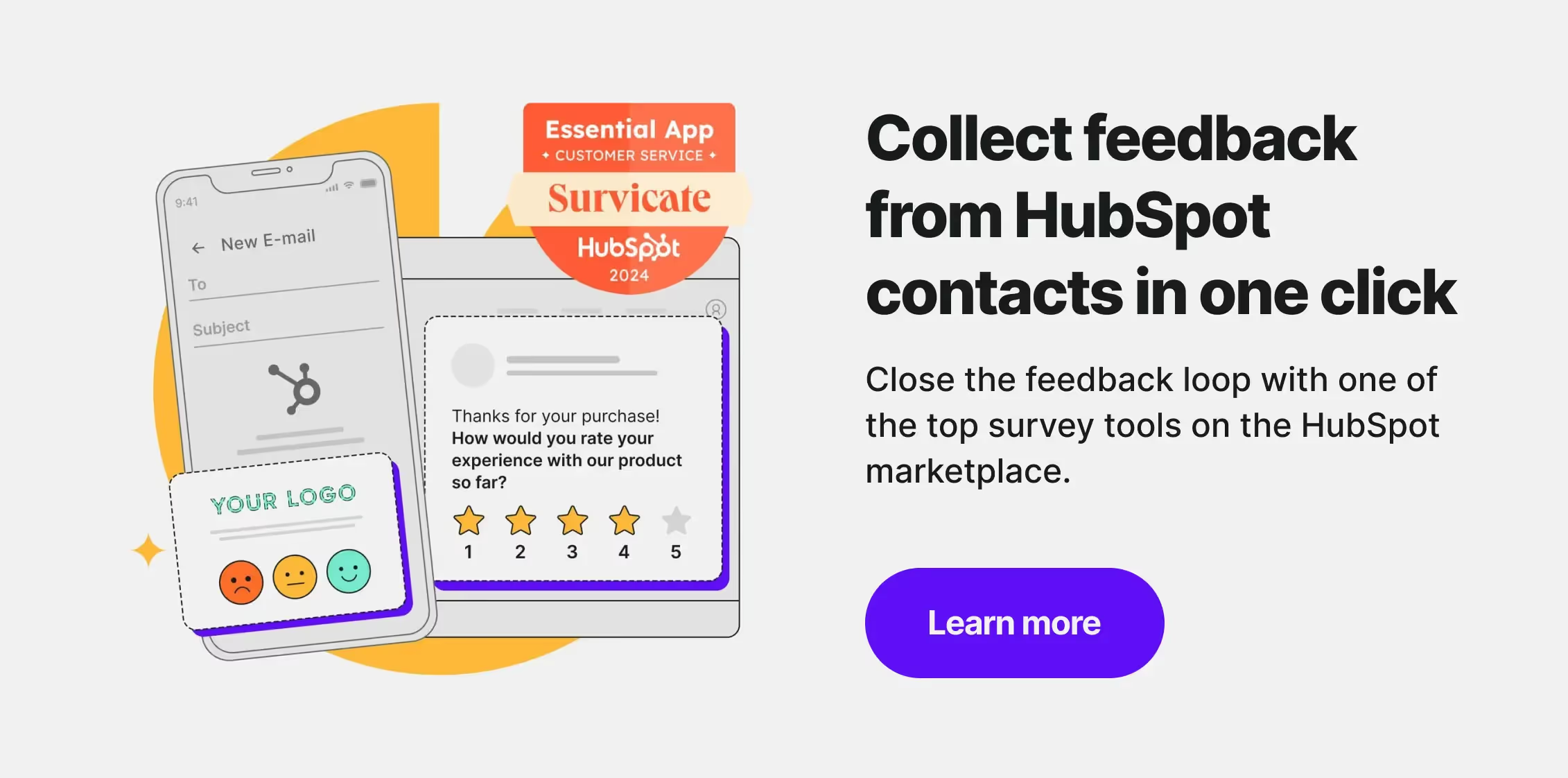
#3. How do you like the app design?
There's no outstanding customer experience without a well-designed user experience. Your customers shouldn't have any trouble navigating through your mobile app—and they should be esthetically pleased while doing so. Otherwise, they'll quickly get frustrated and leave.
Try to gauge how your users feel about your app design as early as possible and tweak it if necessary with the app redesign survey template:
Questions for an early development features scouting survey
#4. Is our app helping you achieve your goals?
This question will let you discover the ideal use cases for your mobile app. You'll find out why your clients install your app and when it's the most useful—and discover if the reality is consistent with your presumptions.
If your app gets the job done for your users, then you're one step closer to building a lasting relationship with them. If it doesn't, ask the survey respondents to clarify their answers with an additional question, such as “What should we improve to help you achieve your goals?”
Either way, you'll easily decide which parts of your app you should focus on. And don't forget to turn your most popular use case into a value proposition.
Here's an app evaluation survey template you can use:
#5. Are there any functions you would like us to add?
Let your customers voice their ideas for new functions or features. Recurring answers—or just one brilliant suggestion—will help you enrich and sort out your feature development process.
This is a good follow-up question to any survey type, so don't shy away from occasionally adding it to your in-app surveys.
#6. How would you rate this new feature?
Every time you implement a new feature, make sure it works as intended and meets your users' expectations.
It's a good idea to add a follow-up question that asks unsatisfied users for clarification—for example, “What do you dislike about this new feature?”
Questions for a product roadmap survey
#7. How often do you use the following features?
This closed-ended question will help you identify the most popular features which are most likely the key to your success.
Always make sure your popular features work well and are easily accessible. And once you identify the least liked parts of the app, think about cutting them off or at least spending fewer resources on them—you don't want to throw money on stuff nobody needs.
Simply run the feature evaluation survey template to identify the most popular features:
#8. Was this feature/button easy to find?
This variation of the CES (Customer Effort Score) question will let you gauge if your most popular features are accessible, helping you to improve user experience and boost customer satisfaction.
General customer experience questions
Once your mobile app is up and running, you have to ensure your users are fully satisfied. When asking general customer experience questions, you should always keep two additional goals in mind:
- Enable your users to share their opinions with you (with the help of open-ended questions);
- Encourage your satisfied users to leave a review or rate you in the app store while avoiding getting negative reviews.
To achieve that, you need to use the skip logic feature and a carefully designed question flow in your surveys. Let's see how to do it in the examples below.
#9. How would you rate your experience with our app?
This is the core question of the CSAT (Customer Satisfaction Score) survey. Its goal is to assess your users' general satisfaction level.
A CSAT survey comes in handy when your mobile app is new and you want to see how it's resonating with its users. But it's a good practice to re-run it regularly (once or twice a year).
You'll be able to create CSAT benchmarks for yourself and monitor the state of your customer experience program.
Always follow up with open-ended questions to get app feedback and ask for reviews. Don't worry if your users are engaged enough to pour their hearts out. Good survey tools, including Survicate, register all the responses—even from partially submitted surveys!
You can use this CSAT template to create your survey in a matter of minutes:
#10. Would you recommend this app to your friend or colleague?
This classic NPS question comes from another battle-tested survey that gauges customer satisfaction.
It will help you discover how many advocates your mobile app has, which can be a future growth indicator. After all, word-of-mouth is the best marketing method out there, and happy customers are much less likely to churn.
The respondents to an NPS survey are divided into three categories:
- 🟢 Promoters—the satisfied users who chose 9 or 10
- 🟡 Passives—the neutral group of respondents who chose 7 or 8
- 🔴 Detractors—the dissatisfied users who chose a score between 0 and 6.
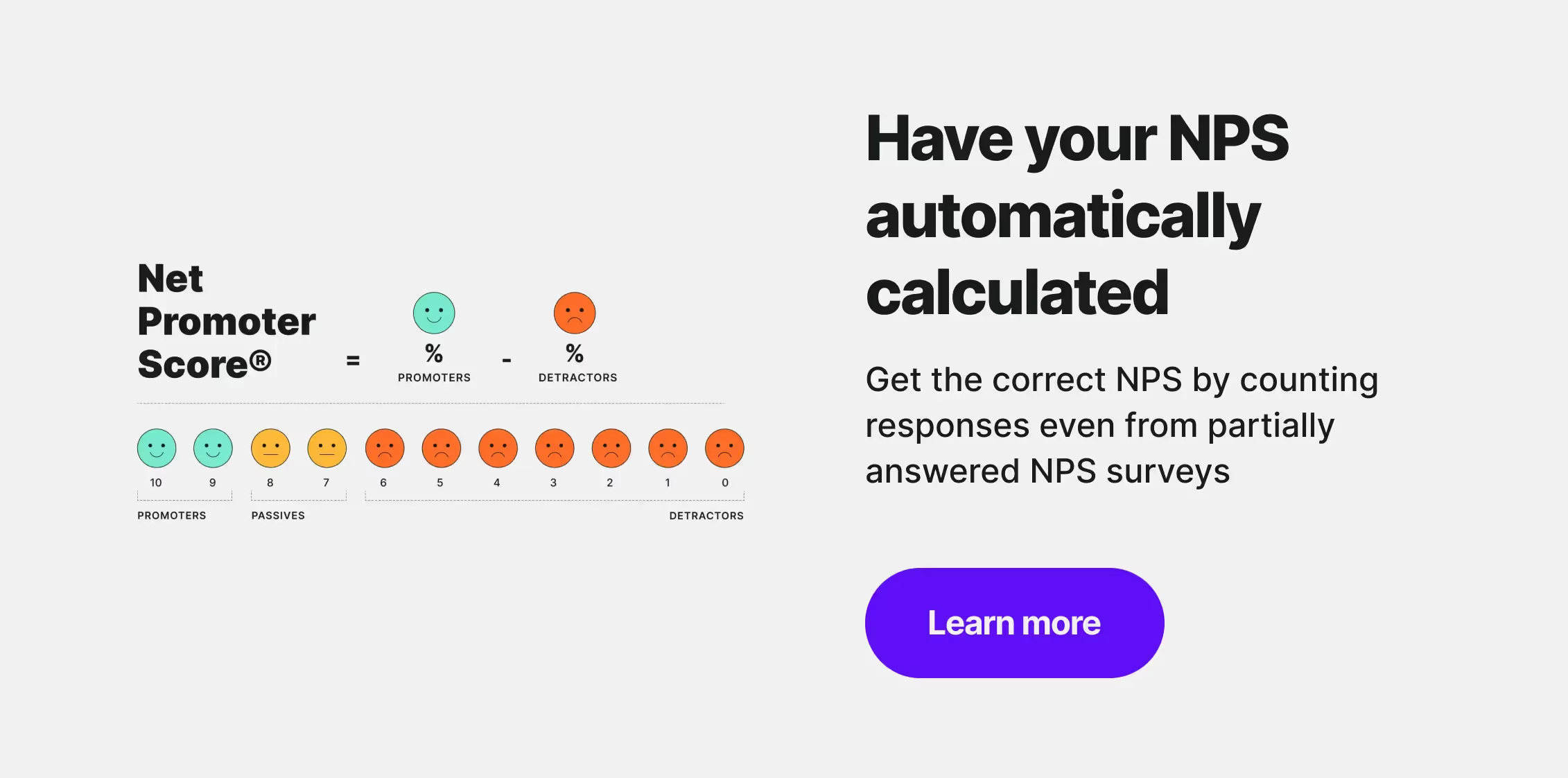
You can show different follow-up questions to each respondent group. Let's review a few options.
Try our Net Promoter Score survey template for free:
#11. What is the reason for your score?
This open-ended question is suitable for both high- and low-rating users. It allows them to share what they like or dislike about your mobile app. In return, you'll get valuable customer feedback you can act on.
Keep in mind that this question is very general—so it's best to use it if you already have an opinionated, ready-to-share audience.
#12. Would you like to leave us a review/rate us on the app store?
Whenever you get a positive score in your CSAT survey (anything over three on a 5-point scale) or NPS survey (9 or 10), you can ask your users to promote you.
It's especially effective as a follow-up question to NPS—after all, the respondent has just said they are willing to recommend you, so why not take them up on their offer?
Ask them to write a review online or rate you in an app store. It's best if you include a link that will quickly redirect your users to the right place.
#13. What can we do to improve the app?
Sending your detractors and dissatisfied users straight to an app store might not be the best idea—let them voice their concerns in the in-app survey instead. Negative feedback is direct instruction on what you should improve in your mobile app to boost customer experience.
Always act on the app feedback you get. Improve the problematic parts of your app, or reach out to your users and make up for your mistakes. You will show them that you care, and you might avoid negative online reviews—or even turn an unhappy customer into a happy one!
P.S. After you figure out your Net Promoter Score, make sure to see how it compares to other companies in your industry. That's the only way to figure out if you're score is actually good! Our 2023 NPS benchmarks report will help you with that.
Mobile app survey questions—best practices
The key to successful mobile app surveys is not just asking the right questions. You need to create an easy, seamless experience that will maximize your response rates.
Here are a few things you should consider when designing a mobile app survey.
Timing is everything
Your surveys need to appear in the right place at the right time.
Just think about it: you wouldn't ask a first-time user to recommend your app to a friend—just like you wouldn't ask a person who's just browsing through your store if they're satisfied with your customer service.
Every time you set up an in-app survey, make sure that:
- It doesn't appear too often. Wait at least a month before you rerun any survey;
- It doesn't disrupt any user flows;
- You trigger event-specific surveys without delay. For example, when your client completes a purchase in the app, show them a survey right away (instead of waiting until they log in the next time).
With in-app feedback tools such as Survicate, you can trigger the survey at specific events or user actions, so you'll easily avoid any awkwardness.
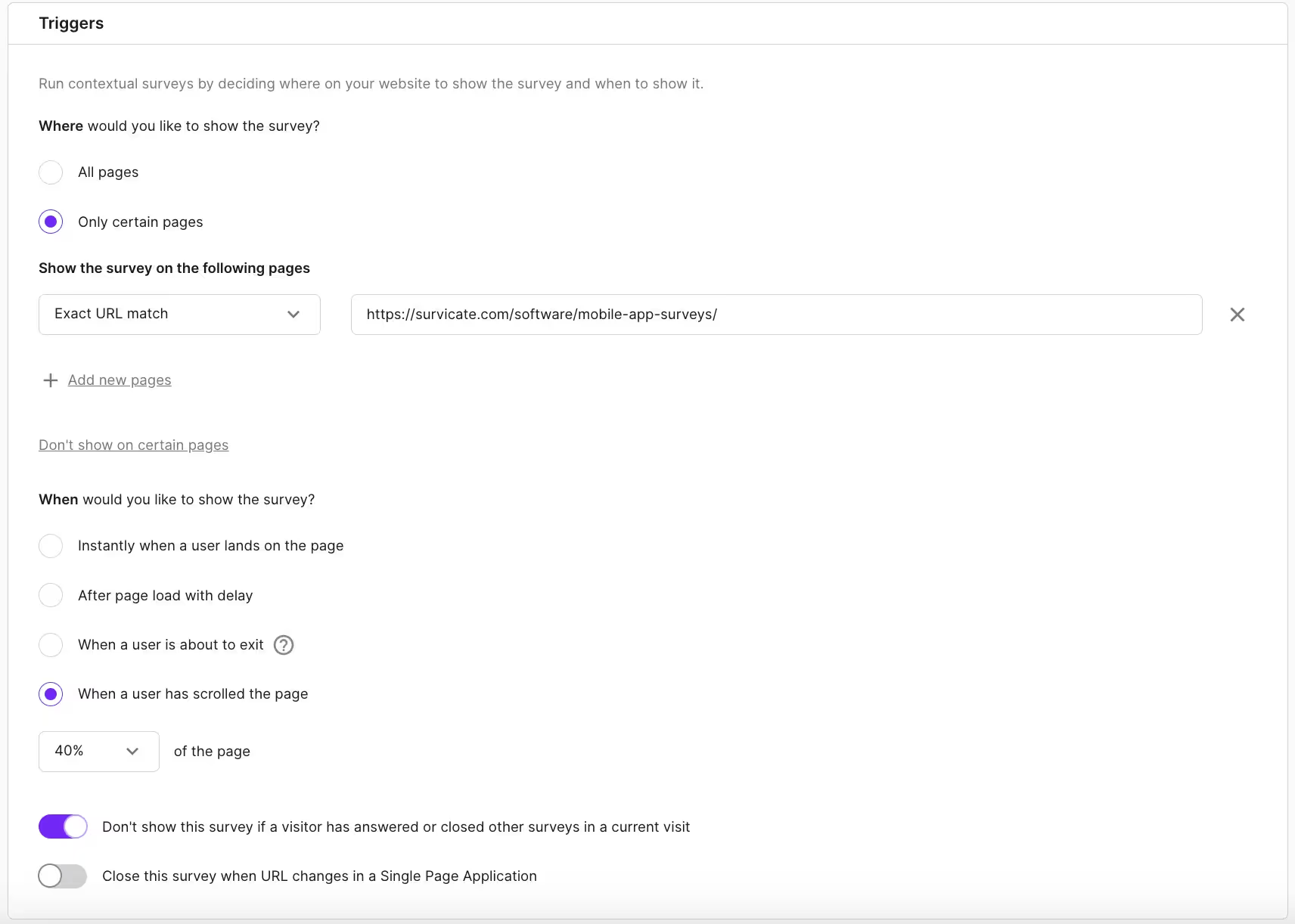
Don't send your users away from the mobile app
When running app-related surveys, make sure the respondents can complete the whole thing in the app. It's as simple as that.
Don't send surveys by email or re-direct your users to a form on your website. This forces them to take an extra step, which might discourage them from submitting their answers. Plus, you're pulling them away from the app—and you have no guarantee they'll come back.
There's also another reason to keep everything in-app. Mobile users' patience wears thin easily, and they have even less tolerance for experience-disrupting elements. The more annoying your survey is, the lower your response rates will be.
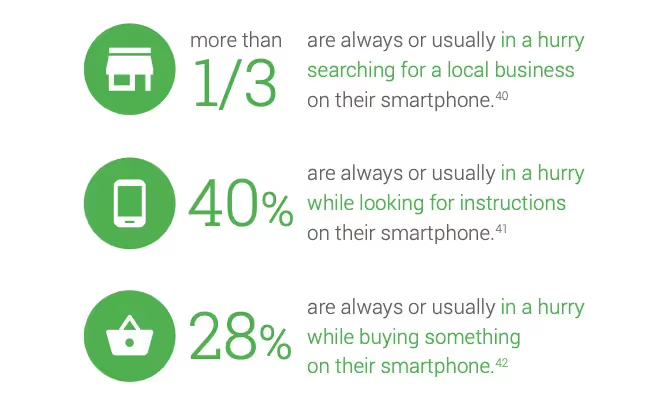
Keep your surveys short
Mobile apps are all about ease of use. Long surveys are the opposite of that.
Try to keep your mobile surveys as short as possible. Prioritize closed-ended questions that only demand one tap on the screen and make the open-ended questions highly contextualized. Don't force your users to think long and hard about their answers!
Avoiding survey fatigue should always be your goal. But if you feel like running more complex surveys, try to leave them for your website, web app, or e-mail—depending on the nature of your business.
Leverage the power of open-ended questions
Open-ended questions are the best way to hear from your customers and get actionable feedback. This is why you shouldn't avoid them, even if they require more work from the users than their closed-ended counterparts.
Here are a few ground rules:
- Use open-ended questions as a follow-up to closed-ended ones when your users are already engaged.
- Keep the flow of the survey logical—stay on topic and stick to two open questions maximum.
- Make sure to always act on any app feedback you get—if your users notice you care, they're more likely to answer your questions again in the future.
Boost user experience with Survicate mobile app surveys
Surveys can help your mobile app reach its goals by elevating the customers' voices. With customer feedback, you will:
- prioritize feature development,
- spot flaws and friction points,
- set up benchmarks and KPIs,
- come up with new features.
Remember to ask the right questions and stick to survey best practices to collect actionable feedback and make the most out of your users' precious time.
Survicate will help you integrate surveys right into your mobile app for the most effortless experience with an easy-to-install SDK for Android and iOS.
Start collecting mobile app feedback with Survicate in minutes! Sign up for free today or explore our pricing.
----
At Survicate, Marta used to create blog articles and helped develop the content strategy. She's also a big fan of value-based marketing, educational content, and cats.









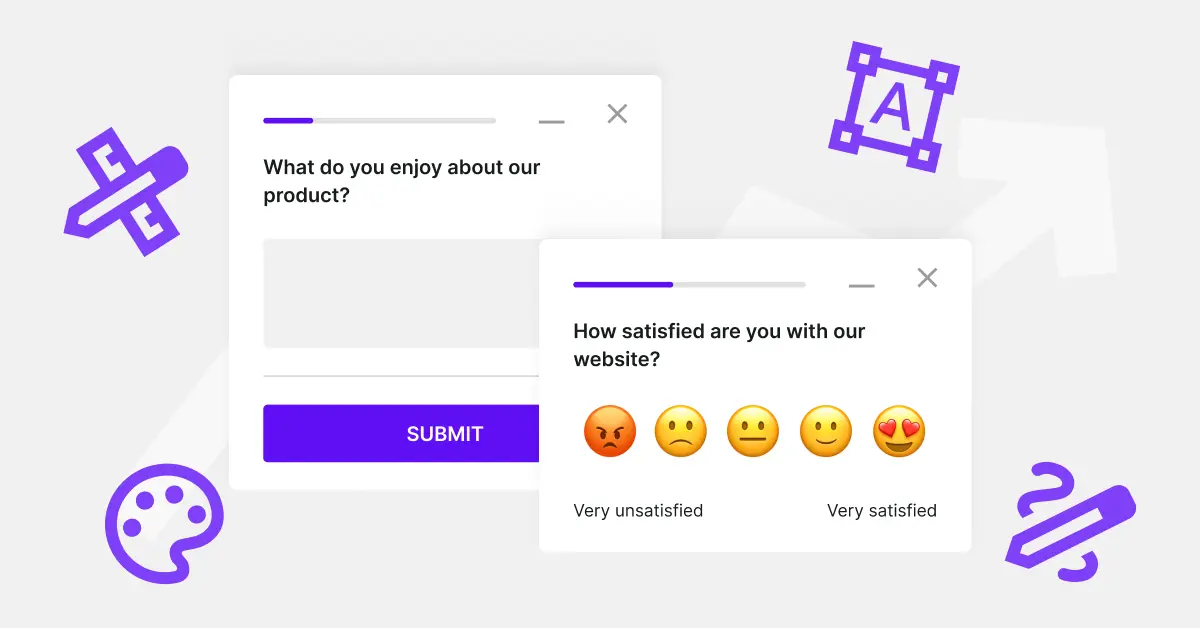
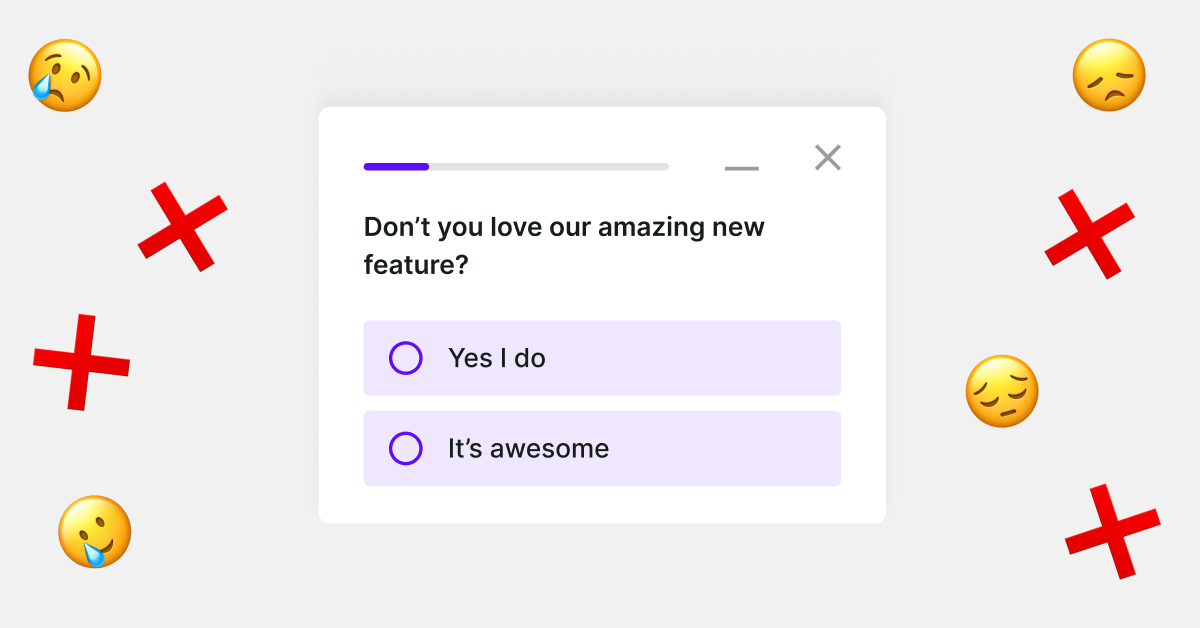
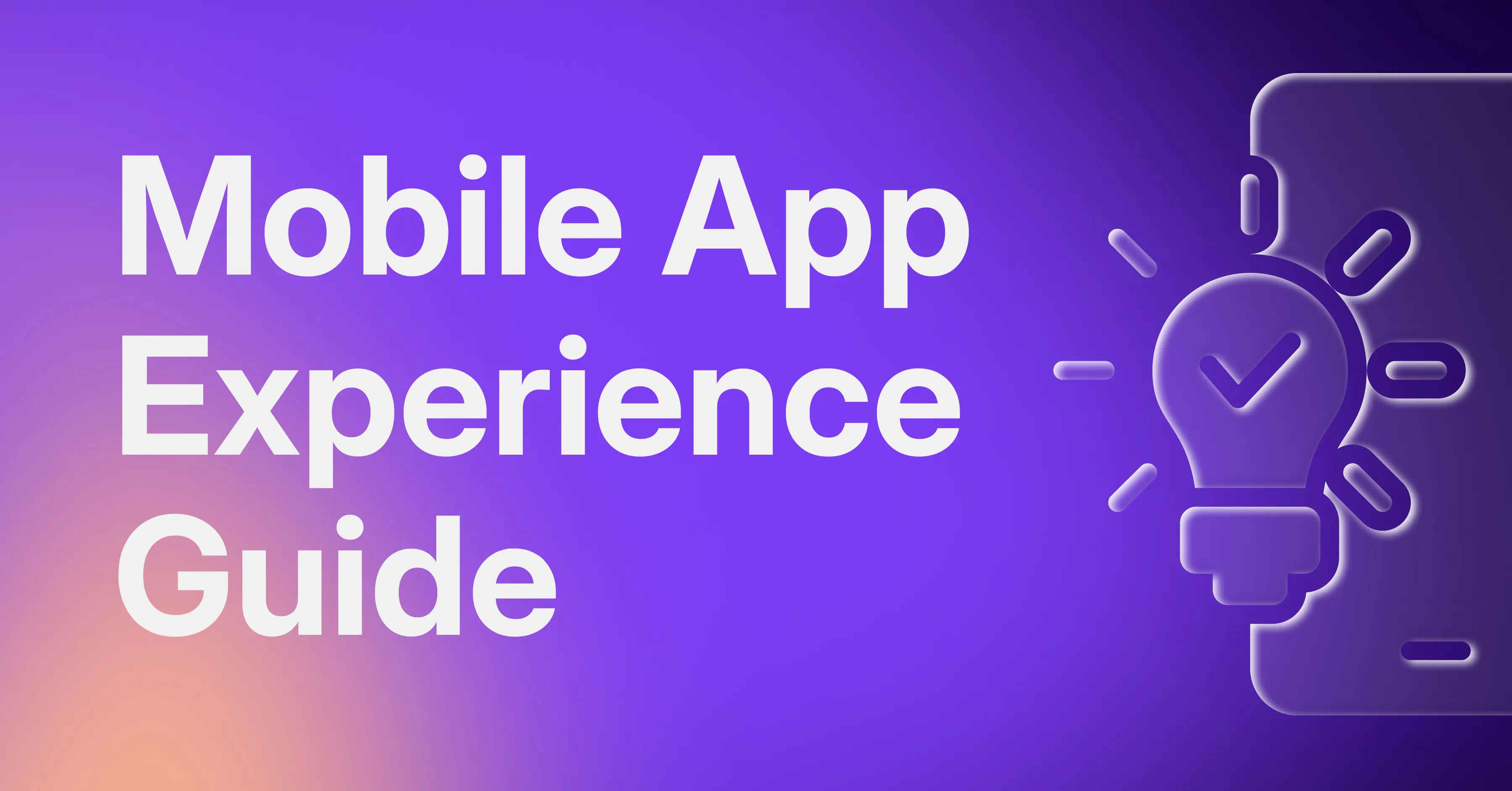
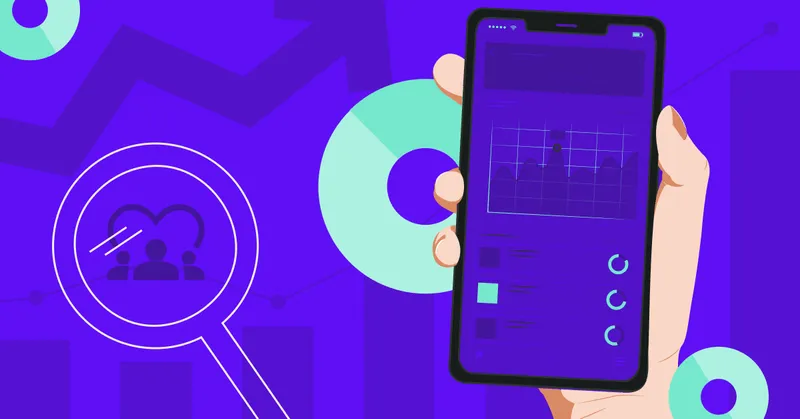
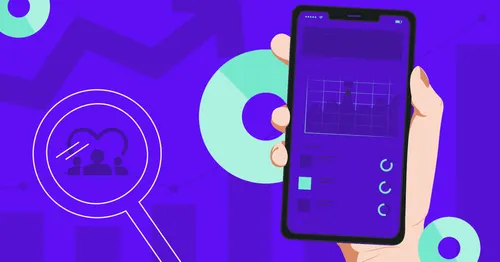

.svg)

.svg)



